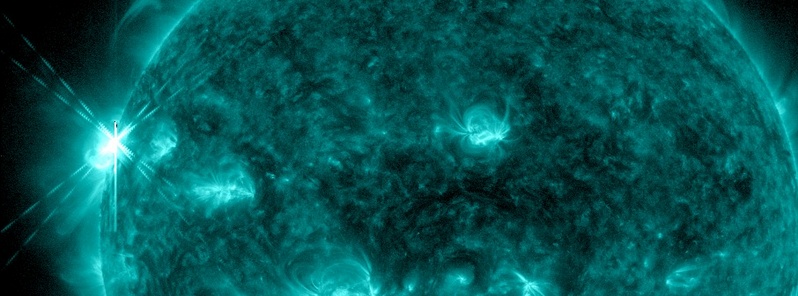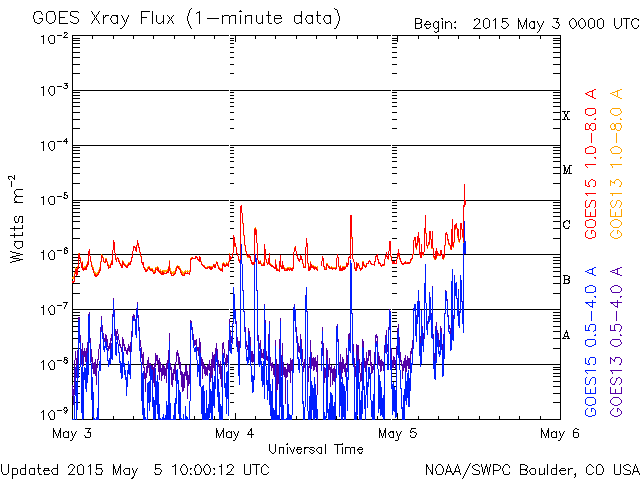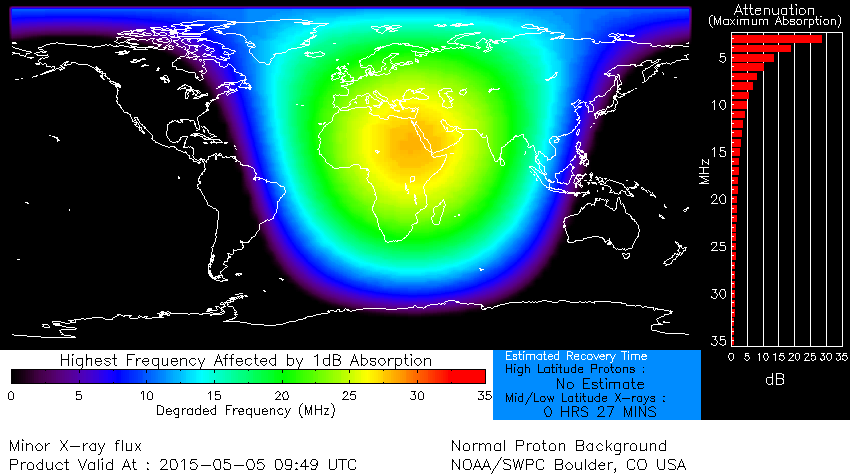Solar activity uptick – M1.9 solar flare erupts from the northeast limb (+ M1.2, M1.3, M2.6 and X2.7)

An impulsive solar flare measuring M1.9 at its peak time erupted at 09:47 UTC on May 5, 2015 from old Region 2322. This region is emerging from the northeast limb for its second transit through the Earth side of the Sun, and is now known as Region 2339. The event started at 09:42 and ended at 09:51 UTC.
A few hours later, Region 2339 produced a second M-class solar flare of the day. It started at 13:45, peaked at 13:53 as M1.2 and ended at 13:56 UTC.
It appears a Coronal Mass Ejection (CME) was produced by this event, however, the location of this region is not favorable for Earth directed CMEs.
Space Weather Message Code: ALTTP2
Serial Number: 1007
Issue Time: 2015 May 05 1418 UTC
ALERT: Type II Radio Emission
Begin Time: 2015 May 05 1351 UTC
Estimated Velocity: 1110 km/s
Description: Type II emissions occur in association with eruptions on the sun and typically indicate a coronal mass ejection is associated with a flare event.
Beta-gamma classified Region 2335, now located near the center of the disk, produced an M1.3 solar flare peaking at 14:25 UTC. That event started at 16:31 and ended at 16:35 UTC.
The fourth M-class solar flare of the day was also produced by Region 2335 and was measured as M2.6. It started at 17:12, peaked at 17:24 and ended at 17:30 UTC.
There were no signatures that would suggest a CME was produced in either of those two events.
Update:
An impulsive, major solar flare reaching X2.7 erupted at 22:11 UTC from Region 2339 producing R3 (Strong) Radio Blackout. The event started at 22:05 and ended at 22:15 UTC.
A Type II Radio Emission with estimated velocity of 1 163 km/s was associated with this event. Type II emissions occur in association with eruptions on the Sun and typically indicate a Coronal Mass Ejection (CME) is associated with a flare event.
Additionally, a 10cm Radio Burst lasting 2 minutes, with peak flux of 590 sfu, was also associated with the event. A 10cm radio burst indicates that the electromagnetic burst associated with a solar flare at the 10cm wavelength was double or greater than the initial 10cm radio background. This can be indicative of significant radio noise in association with a solar flare. This noise is generally short-lived but can cause interference for sensitive receivers including radar, GPS, and satellite communications.
Full report can be reached here.
**end of update**
Solar activity is expected to be low over the next three days (May 5 – 7), with a slight chance for an M-class flare (R1-R2, minor-moderate) due to flare activity from Region 2335 and the return of old Region 2322.
On its last transit, old Region 2322 produced six M-class flares and was likely the source of recent back-sided activity indicated by coronagraph imagery.


Sunpots
There are currently 4 numbered sunspot regions on the Earth side of the Sun.
Region 2335 ('beta-gamma') has rapidly grown over the last couple of days and is now near the center of the disk.

Sunspots on May 5, 2015. Image credit: NASA SDO/HMI
2335 – Beta-Gamma
2336 – Beta
2337 – Beta
2338 – Beta
Newly numbered: 2339 – (old Region 2322)
Geomagnetic field forecast
The geomagnetic field is expected to remain at quiet levels through the majority of May 5 under an ambient solar wind environment.
Unsettled field conditions are expected later today through midday May 6 due to the onset of a negative polarity CH HSS.
Unsettled to active geomagnetic field conditions are likely beginning midday to late May 6 due to the anticipated arrival of the May 2 asymmetrical partial-halo CME associated with disappearing solar filament in the southern hemisphere.
Featured image: NASA SDO/AIA 131 at 09:48 UTC on May 5, 2015.

Commenting rules and guidelines
We value the thoughts and opinions of our readers and welcome healthy discussions on our website. In order to maintain a respectful and positive community, we ask that all commenters follow these rules.